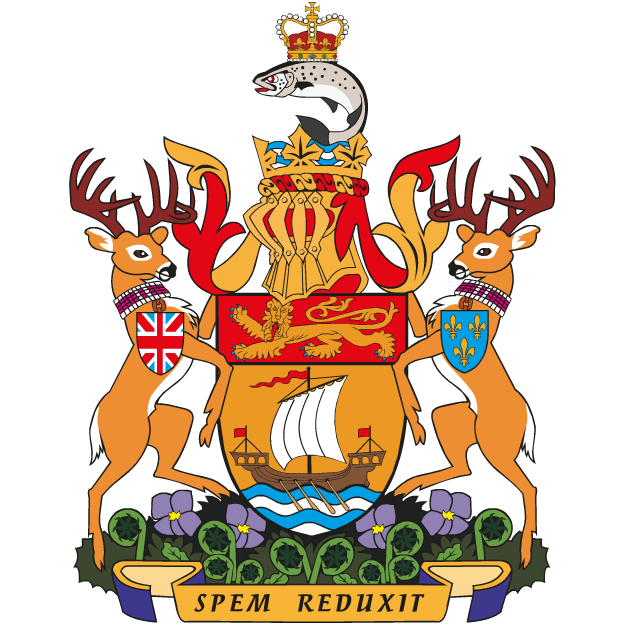new brunswick

On May 26, 1868, Queen Victoria assigned armorial bearings to New Brunswick, consisting of a shield of arms depicting a gold lion on a red background, and below it an ancient galley in the water with oars in action. The design was based in part on the first Great Seal of New Brunswick which featured a sailing ship on water. The lion alludes to the arms of the Duchy of Brunswick in Germany (two gold lions on a red field) which was a possession of King George III at the time the Province of New Brunswick was established in 1784.
On Sept. 25, 1984, at a public ceremony in Fredericton, Her Majesty Queen Elizabeth II signed a royal warrant granting augmentations to the provincial arms. The additions were all symbolic of New Brunswick and consist of a crest resting on a golden royal helmet over the shield, supporters on either side and a compartment below. They were granted by The Queen, in the words of the royal warrant, “for the greater honor and distinction” of New Brunswick and to mark the 200th anniversary of the establishment of the province in 1784.
On April 5, 1989, the augmented armorial bearings of the province were entered in Volume I, page 16, in the new Public Register of Arms, Flags and Badges of Canada, in a special ceremony in the Legislative Assembly chamber in Fredericton. Governor General Jeanne Sauvé, Lt.-Gov. Gilbert Finn and Premier Frank McKenna witnessed this registration — the first of its kind in Canadian history.
The granting of armorial bearings or coats of arms is the prerogative of the Sovereign. In Canada, the exercise of this prerogative now rests with the Governor General, who has established the Canadian Heraldic Authority at Government House to administer this responsibility. The authority’s officers of arms are headed by the herald chancellor, deputy herald chancellor and chief herald of Canada.
The New Brunswick arms, both the grants of 1868 and 1984, were prepared at the College of Arms in London.
Armorial bearings are both an honor to the recipient from the Crown and a means of identification. In the case of a province, they are also a symbol of public authority. Provincial arms are more formally and properly called “armorial bearings of public authority and of particular purpose of Her Majesty The Queen in right of New Brunswick.”
Arms are derived from their ancient use by knights as a means of identification. The shield and crest both served this purpose, with the crests being worn by knights on their helmets. New Brunswick’s crest of an Atlantic salmon leaping from within a coronet of gold maple leaves and bearing on its back St. Edward’s crown, is located over the shield and rests on a gold royal helm. This golden helmet is a special mark of favor to represent provincial authority in honor of New Brunswick’s bicentennial year. It is normally reserved for the arms of members of the Royal Family and of the Dominions. The mantling of gold and red, held in place by a wreath around the helmet, originally served as protection from the sun and takes its colors from the two main tinctures on the shield.
The supporters on either side of the shield are white-tailed deer with antlers, each with a small shield or escutcheon suspended from a friendship collar of Maliseet wampum, the original of which is in the New Brunswick Museum. One shield bears the Union Badge representing the British connection in New Brunswick’s history and the early English, Scots and Irish settlers; the other bears the Royal Arms of France, the symbol of public authority during the French regime, and refers to the French settlement in the province.
The compartment which bears the supporters and the shield is a grassy mound covered with the provincial flower, the purple violet, and the young ostrich fern or fiddlehead.
The motto, Spem Reduxit, taken from the first Great Seal of the Province, is at the base of the arms on a ribbon and can be translated as hope restored. This refers to the establishment of the province as a home for the refugee settlers, the United Empire Loyalists, whose arrival here prompted the creation of New Brunswick by the British government.